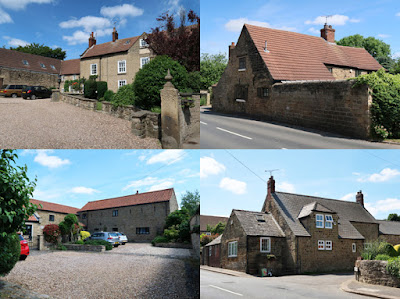 |
| Vernacular architecture on Main Street |
Leaving St. James’ church in Ravenfield, I continued my walk by heading along Church Lane, where I stopped to have a look at the tourist information panel that is set on a blocked doorway to the former garden of the now demolished Ravenfield Hall.
When looking for the POW inscription carved by the Italian prisoners of war who were kept at Ravenfield Park, which is barely discernable, I immediately noticed that the sandstone used to build the boundary wall had yellow and pink/red colour variations, as described in the 1947 geological memoir for the Barnsley district.
This reddening and mottled appearance is a common feature of the Pennine Upper Coal Measures Formation sandstones that lie immediately beneath the Permian strata and is the result of the oxidisation of iron minerals in the sandstone by percolating groundwater in an arid environment.
Continuing along Church Lane into the village, there are several examples of vernacular architecture that are built out of a soft yellowish sandstone, which has similar pink/red mottling to a significant amount of the masonry and does not look like the stone at St. James’s church.
Arriving at Main Street, I was interested to see that the first three of a Grade II Listed terrace of seven cottages are built in the Rotherham Red variety of Mexborough Rock and not the local Ravenfield Rock, which has been used for all of the other buildings that I saw in the village.
Given that the simple cottages were occupied by workers on the Ravenfield Park estate or at the quarries to the south of the village, which mainly produced grindstones, it is surprising that an effort was made to bring stone from another source. Although I have not yet discovered potential sources, it is very probable that the quarry was the same one that supplied stone for the buildings in nearby Hooton Roberts.
I quickly walked to the end of the village to have a look at the rest of the older stone buildings, including the Grade II Listed Oak House and 3-5 Main Street, but I didn’t see anything other than coursed and squared sandstone walling in the fabric that has been used elsewhere.
Retracing my steps back to the centre of the village, I then headed north down Ravenfield Lane where I first came to the very impressive Grade II Listed entrance gateway to Ravenfield Hall, which is built in blocks of massive sandstone.
I was curious to see the old stable block but, with the drive being private property, I could only sneak a view using the zoom lens on my Canon Powershot G7 X Mark II; however, even seen from a distance, the sandstone appears to lack the typical pale yellow colouration and pink/red mottling that is a feature of the Ravenfield Rock used for the vernacular architecture in the village.
Continuing along Ravenfield Lane, I soon came to Hall Mews and photographed the Grade II Listed farm building, again from a distance, but the elevation that I could see was in shade and I cannot determine the characteristics of the sandstone used here.
Having finished photographing the various buildings that were part of the Ravenfield Park estate, I carried on down Ravenfield Lane and hoped to find a shortcut to Thrybergh Country Park. Although I could find no footpaths and had to walk all the way down to Doncaster Road, where there was not much to see, I did encounter a reddened medium grained sandstone in a boundary wall that I thought might be Wickersley Rock.

















































